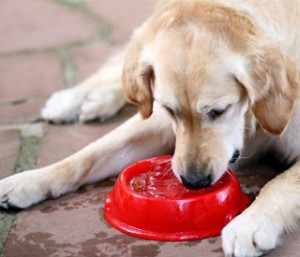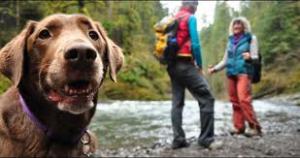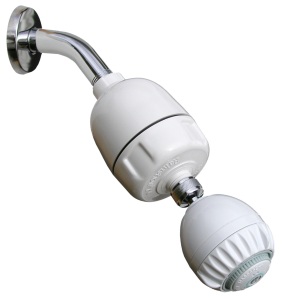Mud puddles can be a source of all sorts of parasites! http://www.peteducation.com/article.cfm?articleid=739
GIARDIA (Giardia canis)
Holly Nash, DVM, MS
Veterinary Services Department, Drs. Foster & Smith, Inc.
Giardia are protozoa (one-celled organisms) that live in the small intestine of dogs and cats. Giardia are found throughout the United States and in many other parts of the world. Infection with Giardia is called ‘giardiasis.’
There are many things we do not know about this parasite. Experts do not agree on how many species of Giardia there are and which ones affect which animals. Veterinarians do not even agree on how common Giardia infections are and when they should be treated. Generally, it is believed that infection with Giardia is common but disease is rare. There is much about the life cycle we do not know either.
How do Giardia reproduce and how are they transmitted?
A dog becomes infected by eating the cyst form of the parasite. In the small intestine, the cyst opens and releases an active form called a trophozoite. These have flagella, hair-like structures that whip back and forth allowing them to move around. They attach to the intestinal wall and reproduce by dividing in two. After an unknown number of divisions, at some stage, in an unknown location, this form develops a wall around itself (encysts) and is passed in the feces. The Giardia in the feces can contaminate the environment and water and infect other animals and people.
What are the signs of a Giardia infection?
Most infections with Giardia are asymptomatic. In the rare cases in which disease occurs, younger animals are usually affected, and the usual sign is diarrhea. The diarrhea may be acute, intermittent, or chronic. Usually the infected animals will not lose their appetite, but they may lose weight. The feces are often abnormal, being pale, having a bad odor, and appearing greasy. In the intestine, Giardia prevents proper absorption of nutrients, damages the delicate intestinal lining, and interferes with digestion.
Can Giardia of dogs infect people?
This is another unknown. There are many species of Giardia, and experts do not know if these species infect only specific hosts. Sources of some human infections have possibly been linked to beavers, other wild animals, and domestic animals. Until we know otherwise, it would be wise to consider infected animals capable of transmitting Giardia to humans.
You may have heard about Giardia outbreaks occurring in humans due to drinking contaminated water. Contamination of urban water supplies with Giardia is usually attributed to (human) sewage effluents. In rural settings, beavers most often get the blame for contaminating lakes and streams. Giardia outbreaks have also occurred in day care centers fueled by the less than optimal hygienic practices of children.
How do we diagnose giardiasis?
Giardiasis is very difficult to diagnose because the protozoa are so small and are not passed with every stool. Tests on serial stool samples (one stool sample every day for three days) are often required to find the organism. Special diagnostic procedures, beyond a routine fecal examination, are necessary to identify Giardia. The procedures we use to identify roundworms and hookworms kill the active form of Giardia and concentrate the cyst form.
To see the active form, a small amount of stool may be mixed with water on a microscope slide and examined under high magnification. Because these forms have flagella, you can see them move around on the slide. The active forms are more commonly found in loose stools. If you ever have the opportunity to see the active form of Giardia under the microscope, take it! It is an interesting-looking creature. It is pear-shaped and its anatomy makes it look like a cartoon face, with eyes (which often look crossed), nose, and mouth. Once you see it, you will not forget it.
Cysts are more commonly found in firm stools. Special solutions are used to separate the cysts from the rest of the stool. The portion of the solution that would contain the cysts is then examined microscopically.
In spring, 2004, a diagnostic test using ELISA technology became available. This test uses a very small fecal sample, and can be performed in 8 minutes in a veterinarian’s office. It is much more accurate than a fecal examination.
We have done the tests, now what?
Now we come to how to interpret the test results. It can be a dilemma for your veterinarian. What you see (or do not see) is not always a correct indication of what you have. A negative test may mean the animal is not infected. However, few, if any, laboratory tests are 100% accurate. Negative test results can also occur in some infected animals. If a negative test occurs, your veterinarian will often suggest repeating the test.
What about a positive test? That should not be hard to interpret, right? Wrong. Giardia can be found in many dogs with and without diarrhea. If we find Giardia, is it the cause of the diarrhea or is it just coincidence we found it? The animal could actually have diarrhea caused by a bacterial infection, and we just happened to find the Giardia. Test results always need to be interpreted in light of the signs, symptoms, and medical history.
If we find Giardia, how do we treat it?
Here we go again; treatment is controversial too. There is a question about when to treat. If Giardia is found in a dog without symptoms should we treat the animal? Since we should not know if G. canis can infect man, we often err on the side of caution and treat an asymptomatic infected animal to prevent possible transmission to people.
If we highly suspect infection with Giardia, but can not find the organism, should we treat anyway? This is often done. Because it is often difficult to detect Giardia in the feces of dogs with diarrhea, if there are no other obvious causes of diarrhea (e.g.; the dog did not get into the garbage several nights ago) we often treat the animal for giardiasis.
There are several treatments for giardiasis, although some of them have not been FDA-approved for that use in dogs. Fenbendazole is an antiparasitic drug that kills some intestinal worms and can help control giardia. It may be used alone or with metronidazole. Metronidazole can kill some types of bacteria that could cause diarrhea. So if the diarrhea was caused by bacteria, and not Giardia, the bacteria can be killed and the symptoms eliminated. Unfortunately, metronidazole has some drawbacks. It has been found to be only 60-70% effective in eliminating Giardia from infected dogs, and probably is not 100% effective in cats, either. It can be toxic to the liver in some animals. It is suspected of being a teratogen (an agent that causes physical defects in the developing embryo), so it should not be used in pregnant animals. Finally, it has a very bitter taste and many animals resent taking it – especially cats.
Quinacrine hydrochloride has been used in the past, but is not very effective and can cause side effects such as lethargy, vomiting, anorexia, and fever.
But now we come to yet another unknown. It is possible these treatments only remove the cysts from the feces but do not kill all the Giardia in the intestine. This means even though the fecal exams after treatment may be negative, the organism is still present in the intestine. This is especially true of the older treatments. So treated animals could still be a source of infection for others.
How can I prevent my pet from becoming infected with Giardia?
The cysts can live several weeks to months outside the host in wet, cold environments. So lawns, parks, kennels, and other areas that may be contaminated with animal feces can be a source of infection for your pet. You should keep your pet away from areas contaminated by the feces of other animals. This is not always easy.
As with other parasites of the digestive system, prevention of the spread of Giardia centers on testing and treating infected animals and using sanitary measures to reduce or kill the organisms in the environment. Solutions of Lysol, bleach, and quaternary ammonium compounds are effective against Giardia.
How do I control Giardia in my kennel?
Infection with Giardia can be a big problem in kennels, and a multi-faceted approach is needed.
Treat Animals: Treat all nonpregnant animals with fenbendazole for 5 days. On the last day of treatment, move them to a holding facility while a clean area is established. When the animals are moved back to the clean area, treat them once again with a 5-day course of fenbendazole or albendazole.
Decontaminate the Environment: Establish a clean area. If possible, this can be the whole facility. Otherwise, create a few clean runs or cages, separate from the others. Remove all fecal material from the areas since the organic matter in feces can greatly decrease the effectiveness of many disinfectants. Steam clean the area. Quaternary ammonium disinfectants used according to manufacturer’s directions or a 1:5 or 1:10 solution of bleach can usually kill the cysts within one minute. Allow the area to dry for several days before reintroducing the animals. NOTE: Use extreme caution when using quaternary ammonium compounds and bleach solutions. Use proper ventilation, gloves, protective clothing and follow your veterinarian’s recommendations.
Clean the Animals: Cysts can remain stuck to the haircoats of infected animals. So during treatment and before moving the treated animals to the clean area, they should be regularly shampooed and rinsed well. Especially concentrate on the perianal area.
Prevent Reintroduction of Giardia: Giardia can be brought into the kennel either by introducing an infected animal or on your shoes or boots. Any new animal should be quarantined from the rest of the animals and be treated and cleaned as described above. You should either use disposable shoe covers or clean shoes/boots and use a footbath containing quaternary ammonium compounds to prevent people from reintroducing Giardia.
Remember, Giardia of dogs may infect people, so good, personal hygiene should be used by adults when cleaning kennels or picking up the yard, and by children who may play with pets or in potentially contaminated areas.
References and Further Reading
Barr, SC; Bowman, DD. Giardiasis in dogs and cats. Compendium on Continuing Education for the Practicing Veterinarian. 1994;16(5):603-614.
Barr, SC; Bowman, DD; Frongillo, MF; Joseph, SL. Efficacy of a drug combination of praziquantel, pyrantel pamoate, and febental against giardiasis in dogs. American Journal of Veterinary Research. 1998;59(1):1134-1136.
Georgi, JR; Georgi, ME. Canine Clinical Parasitology. Lea & Febiger. Philadelphia, PA; 1992;59-61.
Griffiths, HJ. A Handbook of Veterinary Parasitology. University of Minnesota Press. Minneapolis, MN; 1978;21-22.
Hendrix, CM. Diagnostic Veterinary Parasitology. Mosby, Inc. St. Louis, MO; 1998;19-20.
Meyer, EK. Adverse events associated with albendazole and other products used for treatment of giardiasis in dogs. Journal of the American Veterinary Medical Association. 1998;213(1):44-46.
Sherding, RG; Johnson, SE. Diseases of the intestine. In Birchard, SJ; Sherding, RG (eds.) Saunders Manual of Small Animal Practice. W.B. Saunders Co. Philadelphia, PA; 1994;699-700.
Sousby, EJL. Helminths, arthropods and protozoa of domesticated animals. Lea & Febiger. Philadelphia, PA; 1982;577-580.
Zajac, AM; LaBranche, TP; Donoghue, AR; Chu, Teng-Chiao. Efficacy of fenbendazole in the treatment of experimental Giardia infection in dogs. American Journal of Veterinary Research. 1998;59(1):61-63.




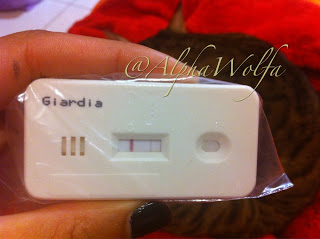

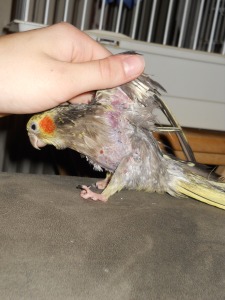

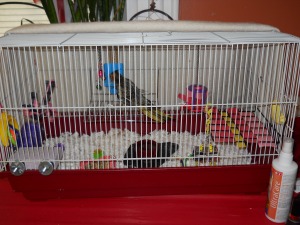 me such a habit that she just does it out of boredom. Not only does she pull her feathers out, but she will also bite and irritate the pore where the follicle comes out, mostly because I’m guessing the feathers itch when they grow back in. So she takes them out before they can even feather. And although I am trying my best to have Erin out of the cage as much as possible, lets face it: I can’t always be there to entertain her. Next year, I’m going to take Erin to school with me, and she will have the three other girls in my suite as well as me to spend as much time as we can with her. But shhh! Don’t tell Duquesne!
me such a habit that she just does it out of boredom. Not only does she pull her feathers out, but she will also bite and irritate the pore where the follicle comes out, mostly because I’m guessing the feathers itch when they grow back in. So she takes them out before they can even feather. And although I am trying my best to have Erin out of the cage as much as possible, lets face it: I can’t always be there to entertain her. Next year, I’m going to take Erin to school with me, and she will have the three other girls in my suite as well as me to spend as much time as we can with her. But shhh! Don’t tell Duquesne!




 for 5 minutes or 162° F for 1 minute. If a dishwasher is not available, submerge dishwasher-safe items in boiling water for at least 1 minute. Toys and bedding can be washed in the washing machine and then heat-dried on the highest heat setting for 30 minutes. If a clothes dryer is not available, allow items to thoroughly air dry under direct sunlight.Â
for 5 minutes or 162° F for 1 minute. If a dishwasher is not available, submerge dishwasher-safe items in boiling water for at least 1 minute. Toys and bedding can be washed in the washing machine and then heat-dried on the highest heat setting for 30 minutes. If a clothes dryer is not available, allow items to thoroughly air dry under direct sunlight.  interests include rowing, cross-country skiing and hiking. She and Steve, along with their three children, have recently relocated to Seattle and are enjoying exploring the Pacific Northwest.
interests include rowing, cross-country skiing and hiking. She and Steve, along with their three children, have recently relocated to Seattle and are enjoying exploring the Pacific Northwest.